Take the next step with bike delivery – it’s time to consider getting an e-bike
Take the next step with bike delivery – it’s time to consider getting an e-bike
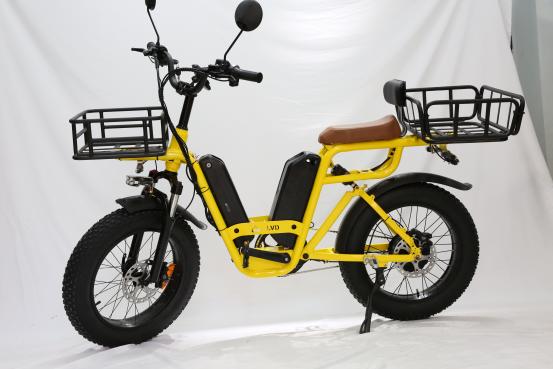
Let us paint a scenario for you…
You’re on your way to pick up an Uber Eats order on your bike, weaving through the helter-skelter traffic idling downtown. Halfway there, you receive a sudden notification from Instacart for another pickup request. In the back of your mind, you realize that – by picking up the Instacart order – you will hit your weekly performance bonus.
Zipping through shortcuts and back alley streets, you know your way around the city, but you already feel your quads burning. This is as fast as you can go! Do you risk falling behind your current orders by accepting the new request? Or do you forgo the chance to pick up your performance bonus?
What do you do?
This is an everyday challenge for bike delivery for food couriers that most people don’t see. Gig platforms are one of the best ways to make money delivering. However, how much you can make with Uber Eats (or any gig platform for that matter) not only depends on your savviness, but also on the resources you are limited to.
Why You Need an E-bike for Food Delivery
Over the past few years, e-bike popularity has trended upwards in most metropolitan cities. E-bikes are the perfect vehicle for couriers and food delivery workers since they’re perfectly suited to navigating tight city streets without sacrificing speed or mobility.
In combination with the advancement of lithium-ion batteries, the cost of battery production has also dropped by 87% in the last 10 years, making e-bikes more affordable and effective for the everyday rider. In the next 3 years, 130 million e-bikes are expected to be sold in the U.S.
Both the economics and practicality of e-bikes makes sense, especially for e-bike food delivery:
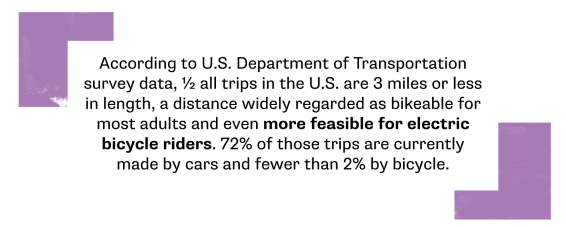
Let’s break down the numbers to better understand our e-bike food delivery economics.
E-bike vs. Road bike: Do more orders in less time
The average bike delivery courier can be paced typically between 10-18 mph. With all things considered, we’ll refine this range to a steady 15 mph for comparison’s sake.
Conservatively, an e-bike can cruise at ~22 mph on city streets. This is 46% faster than your everyday bike! Given that the average commute time is 26 minutes, you would save approximately 12 minutes for each trip, allowing you to complete additional pick-ups in less time.
If you don’t want to sacrifice the time to make more income, e-bikes provide the opportunity for you to re-budget your time.
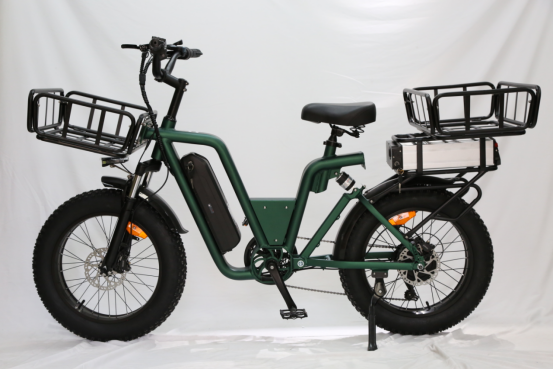
Work longer hours if need be without tiring out
On the contrary, if time isn’t critical but income is – you can work longer hours without getting worn down, especially in hilly cities such as Vancouver or San Francisco. E-bike for winter commuting also seems less daunting with sturdier handling and better performance on slick roads.
Not only can you maximize the number of orders you receive per hour, but you can now also work more hours, optimizing your income generation by two-fold.
Get a better bang for your buck!
A quality electric bicycle can cost on average $1,500-$2,500, versus a $1,000 investment for a mid-range traditional commuter bicycle. Investing in an e-bike is appealing to those who are looking to replace short trips typically made by car without having to find parking so that you can pick up your delivery.
Leaning towards conservative margins – if you were to make 5 additional pick-ups to the sum of $30 each day, it would take ~2 weeks to break even on your additional investment for a $1,500 e-bike instead of a $1,000 commuter bike. At which point, you would be earning an additional $250+/week! Taking this into account, the ‘ROI’ of an e-bike makes budgeting for freelancers much more appealing.
Now let’s look into regulations…
United States
Again, e-bike regulations vary slightly state by state. However, an e-bike is federally defined as:
A two- or three-wheeled vehicle with fully operable pedals
An electric motor of less than 750 watts (1 h.p.),
Whose maximum speed on a paved level surface, is less than 20 mph.
The federal law also permits e-bikes to be powered by the motor alone (a “throttle-assist” e-bike), or by a combination of motor and human power (a “pedal-assist” e-bike).
In contrast to Canada, U.S. federal law only specifies speed limitations under motor power alone. It does not provide a maximum speed when the bicycle is being propelled by a combination of human and motor power, which is how e-bikes are predominantly ridden.
The Consumer Product Safety Commission has clarified that the federal law does allow e-bikes to travel faster than 20 mph when using a combination of human and motor power.
Canada
E-bike regulations are similar across provinces with slight variations in terms of the minimum age requirement.
So long that an electric bicycle has:
Work longer hours if need be without tiring out
On the contrary, if time isn’t critical but income is – you can work longer hours without getting worn down, especially in hilly cities such as Vancouver or San Francisco. E-bike for winter commuting also seems less daunting with sturdier handling and better performance on slick roads.
Not only can you maximize the number of orders you receive per hour, but you can now also work more hours, optimizing your income generation by two-fold.
Get a better bang for your buck!
A quality electric bicycle can cost on average $1,500-$2,500, versus a $1,000 investment for a mid-range traditional commuter bicycle. Investing in an e-bike is appealing to those who are looking to replace short trips typically made by car without having to find parking so that you can pick up your delivery.
Leaning towards conservative margins – if you were to make 5 additional pick-ups to the sum of $30 each day, it would take ~2 weeks to break even on your additional investment for a $1,500 e-bike instead of a $1,000 commuter bike. At which point, you would be earning an additional $250+/week! Taking this into account, the ‘ROI’ of an e-bike makes budgeting for freelancers much more appealing.
Now let’s look into regulations…
Canada
E-bike regulations are similar across provinces with slight variations in terms of the minimum age requirement.
So long that an electric bicycle has:
Working pedals – meaning you must pedal to make the bike move
An electric motor with 500 watts of power or less
handlebars
A weight of no more than 120kg
Along with a top speed of 32km/hr,
then it meets the definition of a ‘power-assisted bicycle.’
In other words, just like a regular bicycle, a food courier is not required to have a license, vehicular insurance, or have your bike registered with the Transportation Ministry. As a result, there is very little friction to become self-employed as an e-bike food courier.
United States
Again, e-bike regulations vary slightly state by state. However, an e-bike is federally defined as:
A two- or three-wheeled vehicle with fully operable pedals
An electric motor of less than 750 watts (1 h.p.),
Whose maximum speed on a paved level surface, is less than 20 mph.
The federal law also permits e-bikes to be powered by the motor alone (a “throttle-assist” e-bike), or by a combination of motor and human power (a “pedal-assist” e-bike).
In contrast to Canada, U.S. federal law only specifies speed limitations under motor power alone. It does not provide a maximum speed when the bicycle is being propelled by a combination of human and motor power, which is how e-bikes are predominantly ridden.
The Consumer Product Safety Commission has clarified that the federal law does allow e-bikes to travel faster than 20 mph when using a combination of human and motor power.
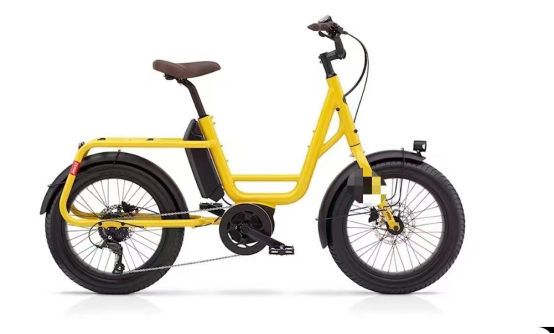
E-bike vs. car – there’s always a time and a place
When it comes to navigating dense cities with lots of traffic, e-bikes is the clear winner. The mobility and affordability of e-bikes make them the prime option for couriers in cities like Toronto where parking can be a rare and expensive commodity.
Being able to pull up onto any sidewalk and using any bike rack is always going to be faster and easier than fighting for parking near busy popular restaurants.
According to AAA, the average annual cost of car ownership after purchase is $9,761, or about $813 per month. This is in stark contrast to the average annual cost of e-bike ownership, totaling $318. Though this dollar figure can be easily reduced if you can perform basic bike maintenance or repairs yourself.
A basic new e-bike costs roughly 90% less than a basic new sedan without any bells and whistles. While you can find a used car for less money, you often end up paying more for it over time thanks to maintenance costs.
It goes without saying, there are clear health and environmental benefits, drastically cutting CO2 emissions and reduces our overall dependency on fossil fuels.
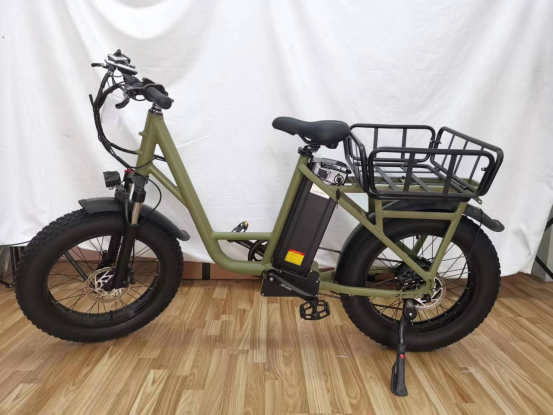
Can you use an e-bike for food delivery?
Yes, you can use an e-bike for Uber Eats, Skip The Dishes, Doordash, and any other food delivery platforms! Using an e-bike is not cheating, and it is not against the rules of any delivery platform. Yet it does give you a distinct advantage over other bike couriers.
Using an e-bike for food delivery can help you move faster, allowing you to complete deliveries faster and take on more potential business. You’ll also be less tired after each delivery, allowing you to stay out longer or to have more energy to live your life.
Find success with Uber Eats on a bike – investing in an e-bike is a significant purchase, however, Gravity wants to help you make informed decisions.
-Gravity Ebikes
info@gravitysz.com
13th/04/23
